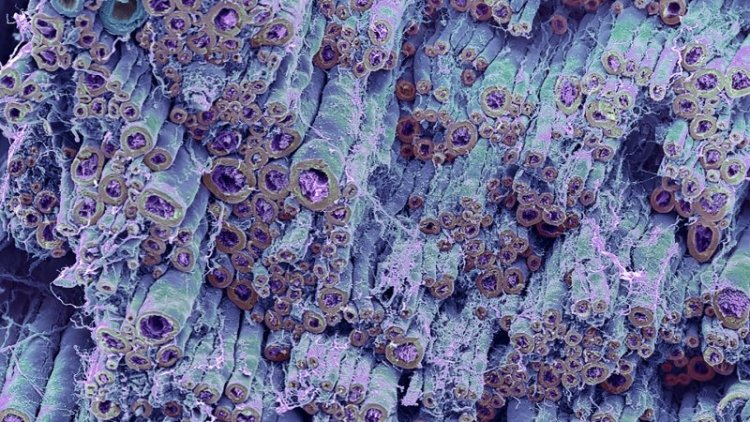Ancient viruses helped speedy nerves evolve
A retrovirus embedded in the DNA of some vertebrates helps turn on production of a protein needed to insulate nerve cells, aiding speedy thoughts.

Ancient viruses have really gotten on our nerves, but in the best of ways.
One particular retrovirus — embedded in the DNA of jawed vertebrates — helps turn on production of a protein needed to insulate nerve fibers, researchers report February 15 in Cell. Such insulation, called myelin, may have helped make speedy thoughts and complex brains possible.
The retrovirus trick was so handy, in fact, that it showed up many times in the evolution of vertebrates with jaws, the team found.
Retroviruses are RNA viruses that make DNA copies of themselves to embed in a host’s DNA. Rarely, these insertions can become a permanent part of who we are, being passed down from parent to offspring. Scientists once thought remnants of of these ancient viruses — known as jumping genes or retrotransposons — as genetic garbage, but that impression is changing, says neuroscientist Jason Shepherd, who was not involved in the study.
“We’re finding more and more that these retrotransposons and retroviruses have influenced the evolution of life on the planet,” says Shepherd, of the University of Utah Spencer Fox Eccles School of Medicine in Salt Lake City.
Remains of retroviruses were already known to have aided the evolution of the placenta, the immune system and other important milestones in human evolution (SN: 5/16/17). Now, they’re implicated in helping to produce myelin.
Myelin is a coating of fat and protein that encases long nerve fibers known as axons. The coating works a bit like the insulation around an electrical wire: Nerves sheathed in myelin can send electrical signals faster than uninsulated nerves can.
Coated nerve fibers can also be thinner and grow longer than they would without insulation, enabling animals to grow bigger, says Robin Franklin, a stem cell biologist at Altos Labs-Cambridge Institute of Science in England. And, he says, thinner fibers can be packed into the nervous system more efficiently.
“As a result of myelin, brains became more complex and vertebrates became more diverse,” Franklin says. “If myelination hadn’t happened in early vertebrate evolution, we wouldn’t have the whole galaxy of vertebrate diversity that we see now.”
Franklin and colleagues went digging in previously collected data for evidence of jumping genes, particularly those that may influence myelin production. They hit paydirt in data on the cells that wrap nerves in myelin: The team found high levels of RNA from an ancient retrovirus.
That RNA, dubbed RetroMyelin, does not have instructions for making a protein itself. Rather, the team found, the RNA latches on to a protein called SOX10, and together they turn on production of myelin basic protein, which zips myelin into a tight sleeve around nerve cells.
When the researchers then used a genetic trick to reduce amounts of RetroMyelin in rat brains, zebra fish and frogs, production of myelin basic protein dropped. That finding suggests that RetroMyelin RNA is important for making myelin.
Other retrotransposons have shaped evolution by creating new switches in the genetic control panels of certain genes or by producing new versions of proteins that regulate activity of genes, says Eirene Markenscoff-Papadimitriou, a developmental neuroscientist at Cornell University who was not involved in the research. But producing RNA to influence activity of a gene is a new trick. The finding is “a very surprising and important demonstration … of a new type of developmental process being made possible by these retroviruses,” she says.
Organisms with vertebrae and jaws, including fish, amphibians and mammals, have RetroMyelin, but lampreys and other jawless fish and invertebrates don’t. While that would seem to suggest that the retrovirus jumped into the common ancestor of jawed vertebrates, that doesn’t appear to have been the case.
The team found that each species they examined had its own version of RetroMyelin, rather than related versions with some minor changes. That pattern suggests the retrovirus infected multiple species at different times yet resulted in the same outcome, a concept known as convergent evolution (SN: 9/6/13).
It isn’t clear why lampreys and other jawless vertebrates don’t have RetroMyelin. One possibility is that the viruses don’t infect lampreys, says study coauthor Tanay Ghosh, a computational biologist at Altos Labs. Or it could be that the viruses did invade lampreys but weren’t evolutionarily useful and have been lost.
For the jawed vertebrates, Markenscoff-Papadimitriou says, having myelin basic protein and other components necessary for myelin production already in place may have been important to take advantage of RetroMyelin. “We’re getting infected constantly, and some of these [viruses] are conferring evolutionary advantage.” Scientists are seeing the success stories in which RetroMyelin probably immediately gave an advantage to the host organism and was kept, she says.
Usually, researchers are interested in genes and RNAs that produce proteins. They filter out noncoding RNAs — ones like RetroMyelin that don’t produce proteins, Markenscoff-Papadimitriou says. But, she notes, scientists are increasingly recognizing that noncoding RNAs also do important jobs (SN: 4/7/19). “This paper will be an inspiration to other developmental biologists to really mine their data to look for the retrotransposons.”
What's Your Reaction?



















